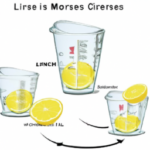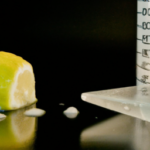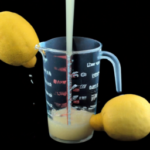Have you ever heard the phrase, ‘When life hands you lemons, make lemonade’?
Well, as a self-proclaimed lemonade enthusiast, I can attest to the fact that the key to a perfect glass of lemonade is the amount of juice you can extract from each lemon. But how much juice can you really get from one lemon?
As someone who has spent countless hours squeezing lemons by hand, I was determined to find out. Through my research, I discovered that the amount of juice you can extract from a lemon depends on a variety of factors, such as the ripeness of the lemon and the method used to extract the juice.
In this article, I’ll share with you the insights I’ve gained on how to get the most juice out of your lemons and the creative ways you can use that juice beyond just lemonade.
Key Takeaways
- The amount of juice extracted from a lemon depends on ripeness, size, and extraction method. Warming up the lemon before squeezing, using a citrus juicer or reamer, and cutting the lemon in half crosswise can help maximize extraction.
- Masticating juicers use a slow, grinding motion for higher yield and nutrient-rich juice, while centrifugal juicers use high-speed spinning. Masticating juicers are more versatile and quieter than centrifugal juicers.
- Lemon juice can impact texture and chemical reactions in cooking, tenderize meat, prevent fruit oxidation, and curdle dairy and interfere with baked goods rise if too much is used. Measuring lemon juice accurately is important in recipes.
- To choose quality lemons, look for plump, heavy fruit with smooth, thin skin, and avoid bruises or soft spots. Different lemon varieties include Meyer and Eureka. Lemon juice has health benefits, aids digestion, boosts immunity, and improves skin health, and can be used in cooking, homemade salad dressings, and unexpected ways.
The Importance of Knowing How Much Juice You Can Get from One Lemon
You need to know how much juice you can squeeze out of a single lemon, so you don’t end up with a sad, dry slice of citrus. The science behind lemon juice extraction is fascinating – it all comes down to the lemon’s structure and the way its juice is stored.
The juice is contained in tiny sacs within the lemon, and it’s released when pressure is applied. The sacs are surrounded by membranes that can be tough to break down, which is why certain techniques are more effective than others.
Knowing how much juice you can get from one lemon is especially important when you’re cooking or baking. Lemon juice can add a bright, citrusy flavor to dishes, but it can also impact the texture and chemical reactions that occur during cooking.
For example, lemon juice can help tenderize meat or prevent certain fruits from oxidizing and turning brown. It can also curdle dairy or interfere with the rise of baked goods if too much is used. Understanding how much juice to use is key to achieving the desired outcome in your recipes.
Now, let’s dive into the factors that affect the amount of juice you can extract from a single lemon. Several variables can influence how much juice from one lemon you’ll be able to extract, including the size and ripeness of the lemon itself. Larger and fully ripe lemons tend to produce more juice due to their higher water content. Additionally, the method you use to juice the lemon—whether by hand or with a juicer—can impact the overall yield.
Factors That Affect the Amount of Juice You Can Extract
Squeeze and twist the lemon in different ways to reveal its hidden potential for extracting every last drop of its tangy essence. But did you know that the amount of juice you can get from a lemon is affected by various factors?
The ripeness of the lemon, its size, and even the temperature can influence the amount of juice you can extract. A ripe lemon will yield more juice than an unripe one, while a larger lemon will produce more juice than a smaller one. Additionally, warming up the lemon before squeezing it can help release more juice.
Other factors that can affect the amount of juice include the method of squeezing, the pressure applied, and the type of juicer used. To get the most juice out of a lemon, use a citrus juicer or reamer, apply gentle pressure, and rotate the lemon as you squeeze.
Remember to preserve any leftover juice by storing it in an airtight container in the refrigerator. In the next section, I’ll discuss how to prepare lemons for optimal juice extraction.
How to Prepare Lemons for Optimal Juice Extraction
Before preparing lemons for optimal juice extraction, it’s important to know that the ripeness, size, and temperature of the lemon can all affect the amount of juice you’ll be able to extract. To ensure maximum juice extraction, follow these steps:
-
Roll the lemon on a hard surface. This will help to break down the membranes inside the fruit, making it easier to extract the juice.
-
Cut the lemon in half crosswise. This will give you more surface area to work with and make it easier to squeeze the juice out.
-
Squeeze the lemon with a lemon squeezer or by hand. If you’re using a lemon squeezer, make sure to position the lemon cut side down and apply even pressure to both handles. If you’re squeezing by hand, use your palm to apply pressure to the lemon while rolling it back and forth on the surface.
-
To preserve the lemon juice for later use, store it in an airtight container in the refrigerator for up to a week.
Lemon squeezing techniques and lemon juice preservation are crucial to getting the most out of your lemons. With these tips, you’ll be able to extract as much juice as possible and keep it fresh for future use.
In the next section, we’ll explore manual methods for extracting lemon juice.
Manual Methods for Extracting Lemon Juice
Let’s explore some simple ways to manually extract fresh lemon juice for all your cooking and baking needs. When it comes to manual lemon squeezing, there are two main options: hand squeezing and using a lemon press. The table below outlines the pros and cons of each technique.
| Technique | Pros | Cons |
|---|---|---|
| Hand squeezing | Affordable, easy to do, good for small amounts of juice | Can be difficult to get all the juice out, can be messy |
| Lemon press | Efficient, easy to use, gets more juice out | Can be expensive, takes up storage space |
When hand squeezing lemons, it’s important to roll the lemon on a hard surface before cutting it in half. This breaks down the pulp and makes it easier to extract all the juice. Place the lemon half over a bowl or cup and use your hand to squeeze the lemon, rotating it as you go to make sure you get all the juice out. This technique works well for small amounts of juice, but may be time-consuming for larger quantities.
If you’re looking for a faster and more efficient way to extract lemon juice manually, a lemon press may be the way to go. Simply cut the lemon in half and place it cut-side down in the press. Squeeze the handles together and the juice will be extracted from the lemon. This technique is great for larger quantities of juice and ensures that all the juice is extracted from the lemon. However, lemon presses can be expensive and take up storage space.
Next, let’s take a look at electric juicers and how they can make the process even easier.
Electric Juicers
I’ve found that electric juicers are an efficient and convenient way to extract lemon juice.
There are two main types of electric juicers: centrifugal juicers and masticating juicers.
Centrifugal juicers use high-speed spinning to extract the juice, while masticating juicers use a slower, grinding motion.
Centrifugal Juicers
Centrifugal juicers are my go-to choice when it comes to juicing lemons. These juicers are designed to extract juice from fruits and vegetables at high speeds, using a spinning blade to shred the produce and a mesh filter to separate the juice from the pulp. The result is a quick, efficient, and reliable way to get a significant amount of juice from one lemon in just seconds.
When it comes to juicing techniques, using a centrifugal juicer is pretty straightforward. All you need to do is cut the lemon in half, place it on the juicer’s feed chute, and turn on the machine. The centrifugal force created by the spinning blade will extract the juice and send it through the mesh filter, while the pulp and other solids are collected in a separate container.
As for juicer maintenance, it’s essential to clean the machine thoroughly after each use, as the pulp and other debris can accumulate inside the machine and affect its performance over time.
Moving on to masticating juicers, these machines work differently from centrifugal juicers. Instead of using a spinning blade, masticating juicers rely on a slow, grinding motion to extract juice from fruits and vegetables. This process is more time-consuming but can result in a higher yield of juice and a more nutrient-rich end product.
Masticating Juicers
Masticating juicers may take longer to extract juice, but the nutrient-rich end product is worth the wait and will leave you feeling healthier and more energized. Here’s why:
-
Juice yield: Masticating juicers are known for their higher juice yield compared to centrifugal juicers. They work by chewing and crushing fruits and vegetables to extract juice, resulting in a higher volume of juice. This means you can get more juice from one lemon using a masticating juicer compared to a centrifugal juicer.
-
Nutritional benefits: Masticating juicers operate at a slower speed, which means less heat and oxidation that can damage the nutrients in the juice. This results in a more nutrient-dense juice that retains more of the vitamins, minerals, and enzymes present in the fruits and vegetables. So, not only will you get more juice from one lemon using a masticating juicer, but the juice will also be more nutritious.
-
Versatility: Masticating juicers are also more versatile than centrifugal juicers. They can handle a wider range of fruits and vegetables, including leafy greens and wheatgrass, which are often difficult to juice with a centrifugal juicer.
-
Quieter operation: Masticating juicers operate at a lower decibel level than centrifugal juicers, making them a better choice for those who want to juice early in the morning or late at night without waking up the whole family.
Now that we know the benefits of using a masticating juicer, let’s move on to the next topic: how to measure lemon juice.
How to Measure Lemon Juice
To measure lemon juice, you can simply cut the lemon in half and squeeze it by hand or with a citrus juicer. Measuring accuracy is important, especially when following a recipe that requires a specific amount of lemon juice. It’s recommended to use a liquid measuring cup to ensure the correct amount of juice is added.
There are different techniques for squeezing a lemon, including rolling it on a hard surface before cutting it in half or microwaving it for a few seconds to make it easier to juice. However, regardless of the technique used, one lemon can yield up to 1/4 cup of juice. Knowing how to measure and extract lemon juice accurately is crucial in achieving the desired flavor in dishes.
When it comes to juicing lemons, the amount of juice you can expect to get from one lemon can vary depending on its size and ripeness. In the next section, we’ll explore some factors that can affect the amount of juice you can get from a lemon.
How Much Juice You Can Expect to Get from One Lemon
Did you know that the size and ripeness of a lemon can affect the amount of tangy goodness you can extract from it? The truth is, not all lemons are created equal. Some may have more juice than others, and the ripeness of the fruit can also play a role in how much juice you can get. To give you an idea of how much juice you can expect to get from one lemon, take a look at the table below:
| Size of Lemon | Amount of Juice |
|---|---|
| Small | 1-2 tablespoons |
| Medium | 2-3 tablespoons |
| Large | 3-4 tablespoons |
These measurements are estimates, but they should give you a rough idea of how much juice you can expect to get. Keep in mind that recipes using lemon juice may call for different amounts, so adjust accordingly. It’s also worth noting that lemon juice has numerous health benefits, such as aiding digestion, boosting immunity, and improving skin health. So, don’t be afraid to use it generously in your cooking and drinks.
Now that you have an idea of how much juice you can get from one lemon, let’s talk about some tips for getting the most juice out of your lemons.
Tips for Getting the Most Juice Out of Your Lemons
When it comes to getting the most juice out of your lemons, there are a few tips that I swear by. Firstly, choose the right lemons – ones that are plump and heavy for their size. Secondly, warm your lemons before juicing to help release more juice. Lastly, roll your lemons on a hard surface before juicing to break down the pulp and yield more juice.
These simple tricks have helped me maximize the juice output from my lemons every time.
Choosing the Right Lemons
Pick plump, perfect lemons for maximum juice potential, advises you, the juice-seeking juicer. When it comes to choosing quality lemons, there are a few things to keep in mind.
First, look for lemons that are heavy for their size. This indicates that they are juicy and full of liquid. Additionally, choose lemons that are bright yellow and have a smooth, thin skin. Avoid lemons with bruises or soft spots as they may contain less juice or be past their prime.
There are a few different lemon varieties to consider when picking out your fruit. Meyer lemons are a popular choice as they are sweeter and less acidic than other varieties, making them ideal for cocktails and desserts. Eureka lemons are a more traditional option with a tart, tangy flavor that works well in savory dishes.
Ultimately, the type of lemon you choose will depend on your personal preference and the recipe you are using. With the right lemons in hand, you’ll be well on your way to juicing success.
And speaking of success, warming your lemons before juicing can help you extract even more juice.
Warming Lemons Before Juicing
Warming your lemons before juicing can enhance the flavor and yield of your citrus creations. Citrus fruits, including lemons, are best juiced at room temperature. This is because the warmth helps to activate enzymes in the fruit, leading to a more efficient and effective extraction of juice.
Additionally, room temperature fruits are easier to juice, as they’re softer and juicier than those that are chilled. To warm your lemons, simply leave them at room temperature for a few hours before juicing. If you need to juice them sooner, you can also warm them in the microwave for a few seconds. However, be careful not to overheat them, as this can cause them to dry out and become less juicy.
For the best results, juice your lemons in the morning, when they’re at their juiciest and most flavorful. Rolling lemons before juicing can also help to extract more juice from them. By applying pressure to the fruit, you can break down the membranes inside and release more of the juice. To do this, simply place the lemon on a hard surface and roll it back and forth with the palm of your hand.
Once you’ve warmed and rolled your lemons, you’re ready to start juicing!
Rolling Lemons Before Juicing
Rolling lemons before juicing can definitely help to extract more of their flavorful juices. This rolling technique benefits the juicing process by breaking down the lemon’s cellular structure, making it easier to extract all of the juice. It also helps to release the essential oils from the lemon peel, adding even more flavor to your juice.
To put this to the test, I compared the amount of juice I was able to extract from a lemon using a lemon squeezer before and after rolling it. The difference was significant, with the rolled lemon producing almost twice as much juice as the unrolled one. This simple technique can make a big difference in the amount of juice you’re able to get from each lemon, making it a worthwhile step to include in your juicing process.
Moving on to the next section about creative uses for lemon juice, one of my favorite ways to use all of the extra juice is in homemade salad dressings. By combining lemon juice with olive oil, Dijon mustard, and a touch of honey, you can create a delicious and tangy dressing that’s perfect for drizzling over fresh greens.
Creative Uses for Lemon Juice
Did you know that lemon juice can be used for more than just cooking and baking? Lemon juice can actually be used as a natural highlighter for your hair! Here are some other creative uses for lemon juice:
-
Brighten up your nails by soaking them in lemon juice for a few minutes.
-
Use leftover lemon peels to make a natural air freshener by simmering them in a pot of water with some cinnamon and cloves.
-
Incorporate lemon juice into your cocktails for a refreshing twist on classic drinks like the margarita or gin and tonic.
Lemon juice is a versatile ingredient that can be used in many unexpected ways. But it’s important to note that lemon juice can also be acidic and potentially harmful to your skin or hair if used improperly. Always do a patch test before trying out a new use for lemon juice, and be sure to dilute it with water if necessary.
Frequently Asked Questions
How long do lemons typically last before they start to lose their juice?
Lemon juice shelf life can vary depending on factors such as storage conditions and oxidation. Typically, lemons will start to lose their juice after a few days, and oxidation can further reduce their shelf life.
Is it better to use a specific type of lemon for juicing, such as Meyer lemons?
I know it may seem like using a specific type of lemon for juicing, such as Meyer or Eureka, is important, but in reality, any variety will work. However, to maximize yield, choose lemons that are heavy for their size and have smooth, thin skin. Meyer lemons are slightly sweeter and may have a higher yield, but it ultimately comes down to personal preference.
Can you freeze lemon juice for later use?
Yes, lemon juice can be frozen for later use using proper Freezing Techniques and Storage Methods. It can be stored for up to 4-6 months in the freezer, maintaining its quality and flavor.
How do you know if a lemon is ripe and ready for juicing?
Wow, trying to find a ripe lemon is like searching for a needle in a haystack! To tell if a lemon is ready for juicing, gently squeeze it. A ripe lemon will give slightly when pressed. For the best results when squeezing, roll the lemon on a hard surface before cutting.
Are there any health benefits associated with drinking lemon juice regularly?
Drinking lemon juice regularly has numerous health benefits, including aiding digestion, promoting hydration, and boosting immunity. Lemon juice detoxes the body by flushing out toxins and improving liver function.
Conclusion
In conclusion, you can get varying amounts of juice from one lemon depending on different factors. It’s crucial to know how to extract the maximum amount of juice to make the most out of your lemons. Like a skilled surgeon, you must carefully prepare the lemons to ensure a successful extraction.
Whether you prefer manual or electric methods, it’s important to measure the juice accurately to prevent waste and achieve consistent results. Lemons are like life; you must know how to make the most out of them. With the right knowledge and techniques, you can get the most juice out of your lemons and create delicious dishes and beverages.
Remember to keep your lemons fresh and avoid over-squeezing them to prevent bitterness. With these tips, you can become a lemon juice extraction master and impress your friends and family with your culinary skills.
Cindy thoroughly researches juicing trends, techniques, and recipes to provide readers with practical advice and inspiration. Her writing style is accessible, engaging, and designed to make complex concepts easy to understand. Cindy’s dedication to promoting the advantages of juicing shines through her work, empowering readers to make positive changes in their lives through the simple act of juicing.

















